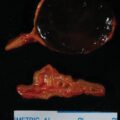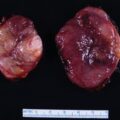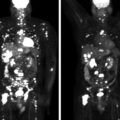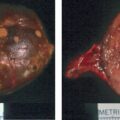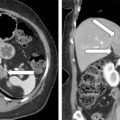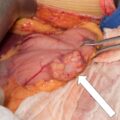Workup for corticotropin (ACTH)-independent hypercortisolism is required in any patient with an adrenal mass, regardless of symptoms of hormone excess. Unfortunately, only a minority of patients with adrenal incidentalomas undergo appropriate workup. Although Cushing syndrome (CS) is associated with physical and metabolic changes, approximately half of patients with adrenal CS are diagnosed incidentally, suggesting poor recognition of CS in the clinical practice. Undiagnosed CS may present with abnormal menses and infertility. During pregnancy, unrecognized and untreated CS may be associated with adverse maternal and fetal outcomes. ,
Case Report
A 41-year-old woman presented for evaluation of an adrenal mass. After searching online for a reason for her symptoms, she came across a description of “Cushing syndrome” and requested further workup. She reported a 5-year history of progressive muscle weakness, weight gain, episodes of diaphoresis, and menstrual irregularity. Over the prior 2 years, she developed moon facies, dorsocervical and supraclavicular pads, erythema, insomnia, difficulty concentrating, and an increase in anxiety and depression. She was diagnosed with new onset hypertension and dyslipidemia 2 years ago. Overall, she gained 50 pounds over the prior 5 years, and 20 pounds in the prior 2 years.
Several years ago, after unsuccessfully attempting to conceive for 12 months, she pursued fertility therapy. During pregnancy, she developed gestational diabetes that necessitated insulin therapy.
Otherwise, her medical history was positive for nephrolithiasis. Two years prior, an abdominal computed tomography (CT) scan was performed that described a 3-cm right adrenal mass. No hormonal workup was performed at that time.
Her current medications included carvedilol, losartan, sertraline, and alprazolam. On physical examination, her blood pressure was 138/88 mmHg and body mass index was 46.64 kg/m 2 . She had no striae or proximal myopathy but did have a dorsocervical pad, supraclavicular pads, and rounding and erythema of the face. She had minimal edema of the lower extremities.
INVESTIGATIONS
Contrast-enhanced CT of the abdomen that was performed recently was reviewed and compared to the CT performed 2 years prior. The most recent CT demonstrated a stable 3.3 × 2.1 × 3.1–cm right adrenal mass ( Fig. 97.1 ). The left adrenal gland was atrophic. Hormonal workup for hypercortisolism was performed, including morning measurement of ACTH and dehydroepiandrosterone sulfate (DHEA-S), 1-mg overnight dexamethasone suppression test (DST), and 24-hour urinary free cortisol excretion. The laboratory data were consistent with ACTH-independent hypercortisolism ( Table 97.1 ). Laparoscopic adrenalectomy was recommended.

| Biochemical Test | Result | Reference Range |
| 1-mg overnight DST, mcg/dL | 12.4 | <1.8 |
| Morning cortisol, mcg/dL | 13 | 7–25 |
| ACTH, pg/mL | <5 | 7.2–63 |
| DHEA-S, mcg/dL | 14 | 27–240 |
| Urine free cortisol, mcg/24 h | “Elevated,” not repeated at our institution | 3.5–45 |
| Aldosterone, ng/dL | 4.4 | <21 |
| Plasma renin activity, ng/mL per hour | 2.1 | 2.9–10.8 |
| Plasma metanephrine, nmol/L | <0.20 | <0.5 |
| Plasma normetanephrine, nmol/L | 0.38 | <0.9 |
Stay updated, free articles. Join our Telegram channel

Full access? Get Clinical Tree



